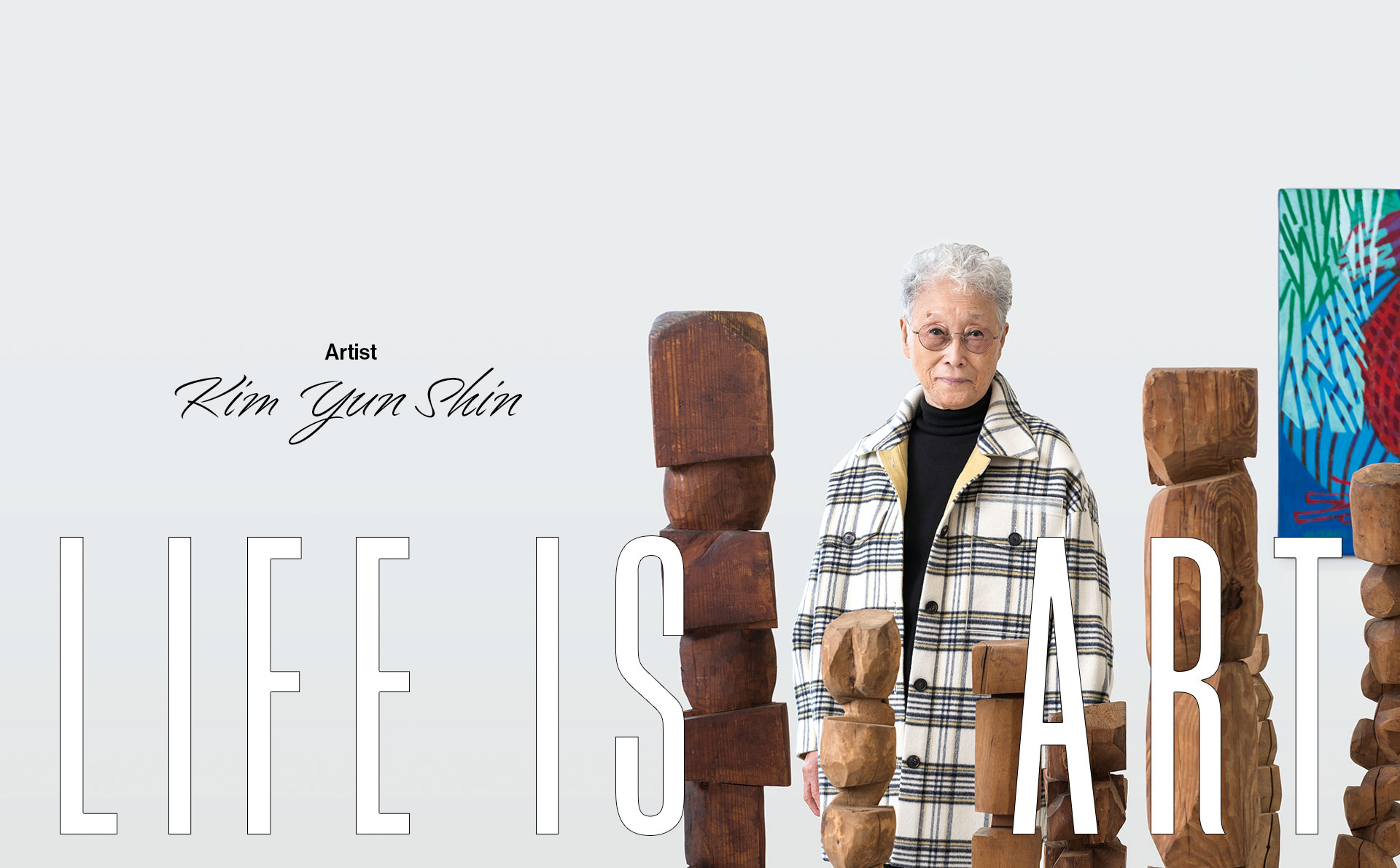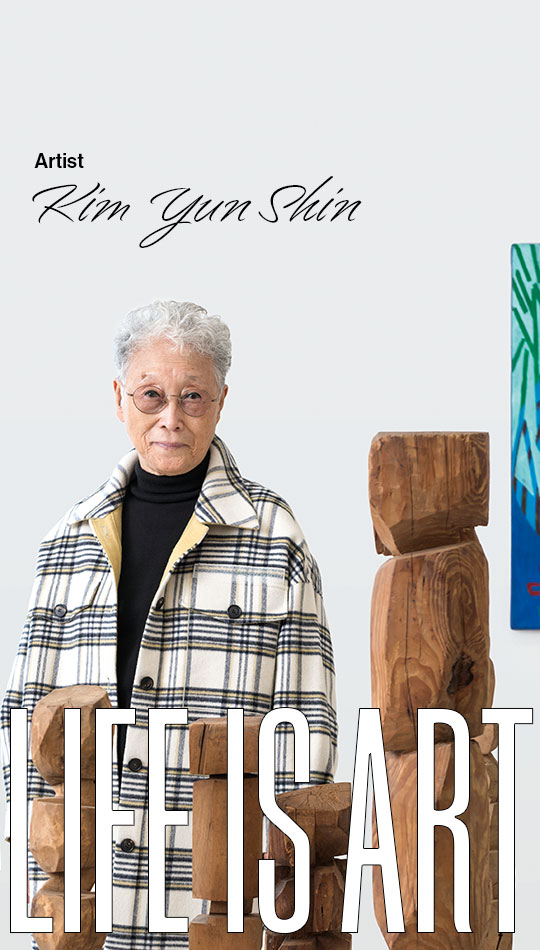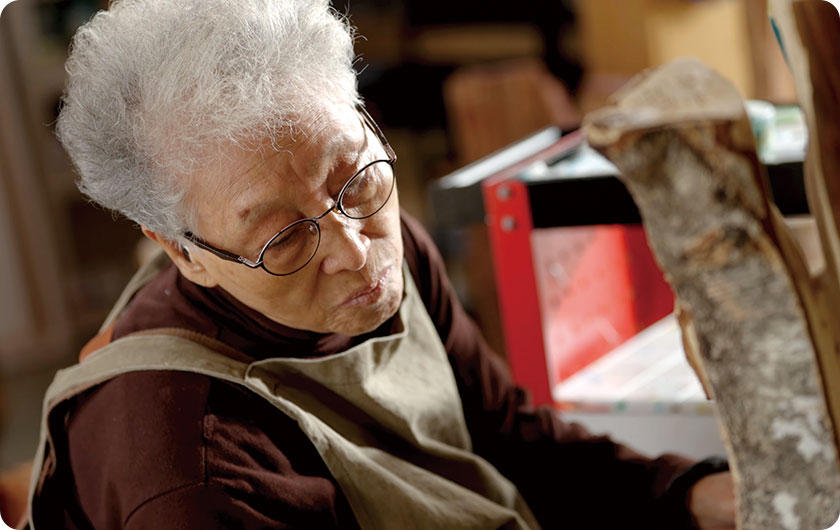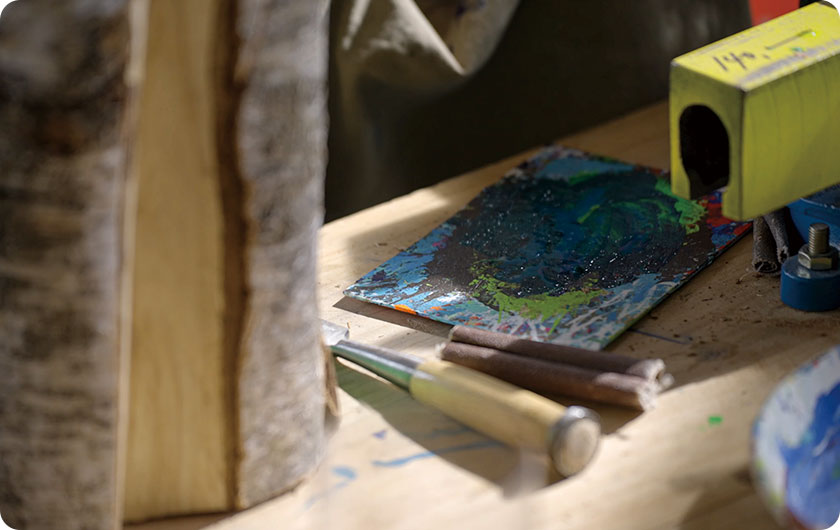As Korean art comes into the global spotlight, one artist who is the talk of the town is enjoying her heyday at the age of 89. Kim Yun Shin, a pioneering member of Korea’s first generation of female sculptors, is back in Korea 40 years after leaving for Argentina in 1983. Since returning home in 2023, her fame has been increasing by the day. Starting with a retrospective at the Nam-Seoul Museum of Art, Kim has also been invited to participate in the Venice Biennale and reached deals with major international galleries, including Kukje Gallery and Lehmann Maupin.


Writer.
Sung Ji Yeon
Photos courtesy of.
Kukje Gallery
The Day an Artist Was Born
The artwork of octogenarian Kim Yun Shin, who is 89 years old, has attracted a passionate following, because of something special that it contains. What people noticed in her paintings and sculptures in the natural materials such as wood and stones, was a harmonious fusion of Korea and Argentina, offering an intimate glimpse into the artist’s own life.
Kim Yun Shin’s journey as an artist began when she met Kim Won, a professor and the mentor of her uncle, a painter. “I went to see a campus exhibition at Hongik University at the professor’s invitation. I was just astonished to see such wonderful and beautiful things. I found the sculptures to be particularly captivating. I found it amazing how the façade could be molded in three dimensions, which inspired me to pursue the arts,” she said.
 Kukje Gallery K1 Kim Yun Shin solo exhibition, Kim Yun Shin installation view
Kukje Gallery K1 Kim Yun Shin solo exhibition, Kim Yun Shin installation view
Kim soon entered the Department of Sculpture at Hongik University. Following her graduation in 1959, she went to Paris in 1964, where she studied sculpture and lithography. While in Paris, Kim spent time with some of Korea’s leading artists, including Lee Ungno, Han Mook, Moon Shin and Suk Ran Hi. Lee Ungno, in particular, would become an advising figure for Kim, while she occasionally tutored Lee in sculpture, helping him produce several wood sculptures.
After completing her studies overseas, Kim returned to Korea, where she spent ten years as a teacher at Sungshin Women’s University. She also established the Korean Sculptress Association to consolidate women sculptors. It was around that time that she happened to visit Argentina for travel. Falling in love with the vast nature and mighty trees of the country, she decided to settle down there.
After seeing Kim’s work, the director of the Museo de Arte Moderno de Buenos Aires (Buenos Aires Museum of Modern Art) arranged for her to hold a solo exhibition. “It was the first time I’d seen sculpture that preserved the tree’s original shape, including its bark, while revealing its heartwood,” the director recalled. As Kim began to make a name for herself as an artist, she would also make a decision that set the course for the rest of her life. “I had to decide whether I should live a comfortable life, making monthly wages, or take the difficult path of becoming an artist. I wanted to live for myself. I wanted to be an artist,” she said.
Kim chose to live in Argentina, where she dedicated several decades of her life solely to her work as an artist. Utilizing various trees such as algarrobo, lapacho, caldén and olive, her pieces seek to achieve visual harmony between the bark and wood. While living in Mexico, she carried out experimental work cutting into stones such as onyx to reveal the subtle colors inside. For three decades following her departure from Korea, she honed a form of expression unique to herself, eventually opening the Museo Kim Yun Shin, an art museum named after herself, in 2008.
 Kim Yun Shin creates work of art in ‘Studio Visit with Kim Yun Shin’, video provided by Kukje Gallery
Kim Yun Shin creates work of art in ‘Studio Visit with Kim Yun Shin’, video provided by Kukje Gallery
Add Two Add One, Divide Two Divide One
The concepts of love and sharing were important parts of Kim’s journey toward building her own world as an artist. Those were the messages she wanted to convey through her work. Just as her artwork was an expression of the assistance and influence she had received from others, she wanted her work to illustrate that despite our existence as separate entities we all live under each others’ influence. She developed that into a philosophy in the mid-1970s, which she encapsulatedin a single sentence: “Add two add one, divide two divide one.” Two can become into one, and even when one is divided into two, it remains parts of one.
“Two entities meet (‘add two’) and combine into one (‘add one’). But if that meeting is results in division, the two are separated (‘divide two’). Ultimately, they become one again (‘divide one’). If I pour all my energy into a material and produce a work of art, that represents ‘add two add one.’ And if my artwork comes to mean something to another person and is ultimately absorbed by that person, that represents ‘divide two divide one,’” she said.
The philosophy of “Add two add one, divide two divide one” also describes her work process, in which she splits one piece of wood into two and then stacks the split surfaces together to create a single work of art. Furthermore, it can be taken as a description of the artist’s very life.
There’s a bigger story here, however. Kim’s philosophy is not just a concept she applies to her work. By her words, it’s an operational principle of the universe itself. “External entities become part of me, and parts of me form entities. That’s why I think of the concept of division as love itself. The whole world revolves around that principle.”
 Granted Wishes 2018-18 , 2018, mixed media on canvas, 120x100 cm, courtesy of the artist and Kukje Gallery, photo: Chunho An
Granted Wishes 2018-18 , 2018, mixed media on canvas, 120x100 cm, courtesy of the artist and Kukje Gallery, photo: Chunho An
Living for the Moment
Kim sees her artwork as an embodiment of herself. For Kim, artwork cannot be created until her thoughts and movements are synchronized with the material. She believes this to be the only way to adequately communicate her intended message. As such, she insists on producing her work solely by herself.
“Some of my friends have suggested I bring on an assistant, but I don’t want to do that. If I borrow somebody else’s strength, then the artwork isn’t mine. Every last dot has to be mine. So when there are days I don’t make much progress, I just have to live with that. I have to be the one doing things, whether they work out or not,” she said.
To the question of if she ever gets exhausted, her nonchalant answer is that simply picking up her saw is enough to wash away her fatigue. I don’t suppose most people would regard picking up a power saw and moving around logs as a panacea for the body’s aches and pains, but that just shows the depth of Kim’s love and passion for her work. So I asked Kim what she was planning to do next, assuming she would have some idea of her next project.
But Kim insisted that she doesn’t make plans. For her, planning artwork and then executing those plans would mean failing to base her work on the “now.” She doesn’t see that as creativity. The only moment that matters to her is when she’s coexisting with her work.
“Before beginning my work, I go to the place where I’ve stacked up my wood. I begin a conversation. I examine its form, color, fragrance and bark, focusing solely on the moment. That’s when I see the path I should take. I just follow that path, and before I know it, my artwork is complete. My artwork doesn’t come into being because I want it to. It just happens that way,” she said.
Kim remains focused on the work process, her material and her desire for self-expression, with no interest in storing her previous artwork or planning her next one. Even so, she has one goal: continuing to make artwork until her last breath.
“I’ve still got a long way to go. There are still a lot of things I don’t know: what art means, and what we ought to do in the future. But I’ve been given so many things so far. I ought to leave something behind for future generations,” she said.
One who lives and breathes for art. One who speaks on trees and stones with pure enthrallment and joy. One who is filled with passion even nearing the age of 90. One who has injected her life with a creative philosophy. We introduce Kim Yun Shin, whose existence is an example to follow. If you ask me what art is, she is Kim Yun Shin.

